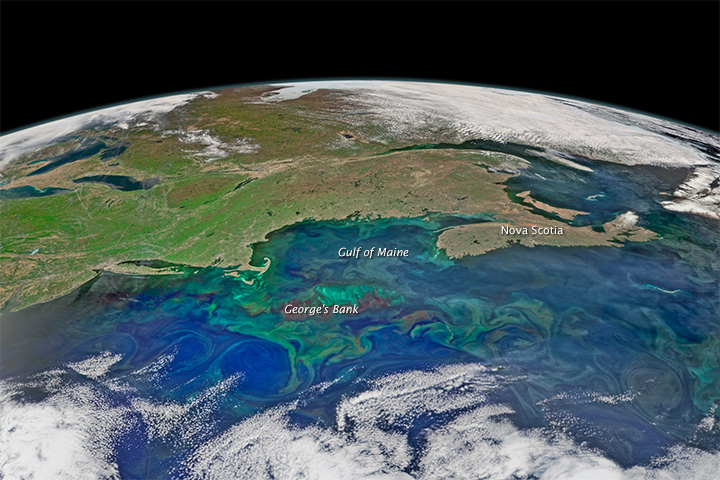Spring Colors Swirl in Picturesque North Atlantic

The northwest Atlantic dons swirling spring colors in a new satellite image taken May 14.
Created by the NASA OceanColor group, the striking image is a composite made with data from the Visible Infrared Imaging Radiometer Suite on the Suomi NPP satellite, according to NASA's Earth Observatory. Nova Scotia, the Gulf of Maine and New England are visible in the background, while spirals of plankton dominate the foreground.
The ocean colors seen aren't just beautiful — they're productive. Photosynthesizing phytoplankton are the basis of the ocean food chain, just as plants form that base on land. And just as plants blossom in spring, phytoplankton in the North Atlantic Ocean spring into action this time of year, forming massive blooms that feed the ecosystem and absorb the greenhouse gas carbon dioxide. [Earth from Above: 101 Stunning Images from Orbit]
Lots of factors play a role in these springtime blooms, including nutrients from onshore and extra springtime sunshine. But a 2010 study in the journal Ecology suggests these little plankton get their start in the depths of winter. As explained in Scientific American magazine, winter storms churn the ocean, diluting phytoplankton and effectively hiding them from the larger zooplankton that feed on them. This gives the phytoplankton a head start and appears to allow them to explode in numbers once the winter turbidity settles down and the sun starts to shine.
The new NASA image reveals even more complexity. Circular eddies of plankton trace stray currents from the jet stream. The area of particularly bright aqua-colored water just outside of the Gulf of Maine is the shallow Georges Bank, an underwater plateau. There, the combination of shallow water with the Gulf Stream and Labrador currents promotes a thriving ecosystem, according to the Earth Observatory. Research ships in the area reported blooms of diatoms, which are plankton with glassy shells made of silicon dioxide.
Phytoplankton appear throughout the world's oceans, even under Arctic sea ice. They play an important role in the climate system, thanks to their habit of consuming carbon at the ocean's surface and then, at the end of their life spans, sinking down to the seafloor with this carbon load, sequestering it from the atmosphere. As a result, some scientists have suggested that fertilizing the ocean with an important phytoplankton nutrient, iron, could create more carbon-sucking phytoplankton and mitigate global warming. The idea is controversial, though, because it could inadvertently encourage toxic algae blooms or even oceanic "dead zones," which occur when decomposing plankton deprive the water of oxygen.
Follow Stephanie Pappas on Twitter and Google+. Follow us @livescience, Facebook & Google+. Original article on Live Science.
Sign up for the Live Science daily newsletter now
Get the world’s most fascinating discoveries delivered straight to your inbox.

Stephanie Pappas is a contributing writer for Live Science, covering topics ranging from geoscience to archaeology to the human brain and behavior. She was previously a senior writer for Live Science but is now a freelancer based in Denver, Colorado, and regularly contributes to Scientific American and The Monitor, the monthly magazine of the American Psychological Association. Stephanie received a bachelor's degree in psychology from the University of South Carolina and a graduate certificate in science communication from the University of California, Santa Cruz.









